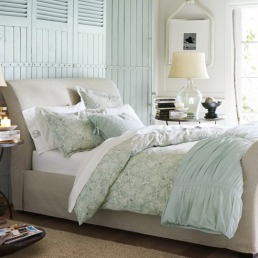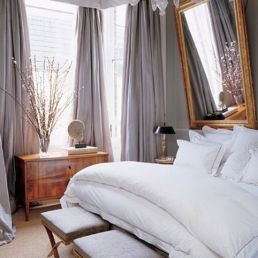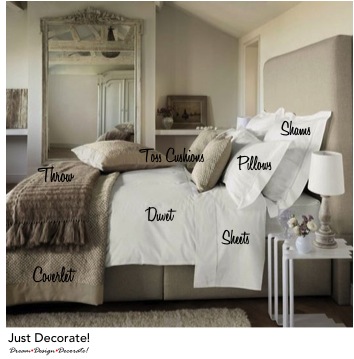We spend about a third of our lives sleeping. When you spend this much time in bed it’s worth your while to make it as comfortable as possible. My philosophy has always been, spend the most you can afford on the things that come into contact with your body. Creating a beautiful and comfortable bed is just a matter of a few good choices.



1. Start with the best bed sheets you can afford. One hundred percent cotton is best because cotton allows air to flow and keeps your body more comfortable through the night. The type and quality of cotton will determine bed sheet comfort. The best grades of cotton are Egyptian, Combed Cotton, Pima or Supima (registered and licensed). There are also many cotton/polyester blends which are produced to reduce cost. I have yet to find a cotton/poly blend I like. The type of cotton is usually identified on the label so look for one of these four.
Long-staple cottons include Egyptian, pima, and Supima®. Look for “certified” long-staple cottons.
Combed Cotton has been combed to remove short fibres so that only long fibres remain, making a stronger and softer yarn.
The bed sheet finishing is also important and the most common are Percale and Sateen. Either one is a matter of personal preference.
Percale is defined as crisp, durable plain weave fabric typically used for sheets; it has a thread count of at least 180.
Sateen is cotton cloth made with a satin weave, a weave that produces a very soft, lustrous feel but can be somewhat less durable than a tighter weave.
If you like soft sheets, choose a sateen but if you prefer crisp sheets, try percale.
We’ve all heard about the hype on thread count. The higher the thread count per square inch was once considered the determining quality factor. A thread count of 200 or more in combination with good quality cotton is a better sheet than 1000 thread count of standard cotton. There is really no need to go higher than 400 thread count. In fact, many sheets with a thread count higher than 400 are usually fudging the truth by using a weaving process to mislead.
And finally on bed sheets, if you are hoping that opening the package to determine the best feeling sheet will lead you to the best deal- you are being duped. The truth is bed sheet manufacturers add hand feel enhancers and/or silicone softeners that wash out. Always wash bed sheets before placing them on your bed and if you don’t like how they feel after the first washing, return them!
So what would I recommend? A 100% Egyptian or combed cotton sateen with 300 to 400 thread count from a reputable retailer should cost you some where between $50 to $80.
2. Top of bed refers to comforters and duvets.
Comforters are most commonly made of synthetic fill with no mention of fill weight on the label and are usually pre-covered from the manufacturer. The market place is full of ready-made comforters and comforter sets. They are usually well priced and fashionable. However, you never really know what’s in them and the weight is usually low to meet a price point. Most synthetic comforters are hypoallergenic but I suggest you pre-wash all synthetic comforters before placing on your bed. Laundering ease is the best selling feature of a synthetic filled comforter.
Duvets are sold without a finished decorative cover. If you like to change your top of bed design often or just seasonally than a duvet is best for you. There are a number of natural duvet options, but down is most often recommended due to it’s flexibility. Not to mention, again, natural is best for breathability. Natural fill includes feathers and down, but feathers and down differ greatly. Down is taken from the under belly of cold weather water fowl. Natural down is very light, almost as light as air. Feathers are much heavier and stiffer with sharp pointy quills. Feather, unlike down don’t make good insulators and are best used for decorative cushions. Down duvets are sold with different weight fills, so you can customize how much or how little warmth you prefer. Except in rare occasions, feather and down allergies are a result of dust and dirt collected inside the duvet, not the down itself. Allergy sufferers shouldn’t necessarily discount feather and down.
There is so much to learn when it comes to natural fill, but in the end a natural down duvet is an investment for a lifetime and you really do get what you pay for.
Silk duvets are made from fibres layered on top of each other, which gives silk duvets a flatter appearance when compared with duvets filled with down. Silk duvets increasing popularity stems from a combination of factors, including their thermal properties, their light weight, and their natural hypoallergenic properties. The best silk duvets are made from wild silk or Grade A Mulberry silk. A good silk duvet is usually the most expensive of the 3 types of bed covers.
Keep in mind that for natural bedding to be effective the baffle material (that which keeps the down in it’s place) and duvet cover must be 100% cotton.

3. Layering a bed adds comfort and helps define the style of the bedroom. By the way, decor magazines get that full bedding look by using a high fill count down duvet with decorative covers. Add a coverlet to the foot of your bed for chillier nights. A coordinating coverlet can add color and texture to any bedroom. A throw contributes to further the designer finish in the bedroom. Always use your pillows to add another layer with decorative shams. Finally, finish with decorative cushions in accent colors to create that off-the-page-of-a-decor-magazine look.




THIS BLOG claims no credit for any images posted on this site unless otherwise noted. Images on this blog are copyright to its respectful owners. If there is an image appearing on this blog that belongs to you and do not wish for it appear on this site, please E-mail with a link to said image and it will be promptly removed.
Original article and pictures take secure.gravatar.com site
Комментариев нет:
Отправить комментарий